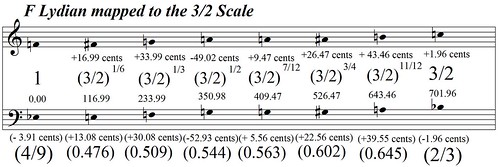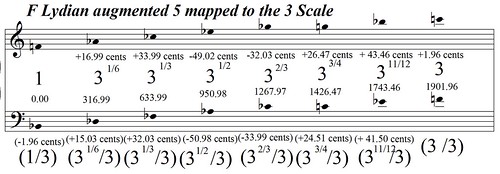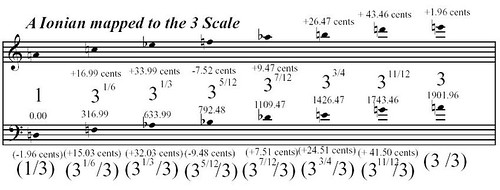
The E Phrygian no 4 Scale as one would find it on any conventionally tuned, equal tempered instrument. This one is a simple scale. On a standard piano it would be all the "white" notes with the exception of A and with E as the tonic.
 James Blood Ulmer: Birthright. 2005. Hyena Records: TMF 9335.
James Blood Ulmer: Birthright. 2005. Hyena Records: TMF 9335. Giacinto Scelsi: 5 String Quartets/String Trio/Khoom. 1988. WDR/Salabert: MO-782156.
Giacinto Scelsi: 5 String Quartets/String Trio/Khoom. 1988. WDR/Salabert: MO-782156. Ludwig van Beethoven: Symphony No. 3 in E flat major (op.55) "Eroica", performed in 1994 by The Royal Philharmonic Orchestra. The International Music Company: 205297-305 (disc 2). Conducted by Guenther Herbig.
Ludwig van Beethoven: Symphony No. 3 in E flat major (op.55) "Eroica", performed in 1994 by The Royal Philharmonic Orchestra. The International Music Company: 205297-305 (disc 2). Conducted by Guenther Herbig. The Jack Wright Trio @ The Red Room, Baltimore, MD - May 26, 2007
The Jack Wright Trio @ The Red Room, Baltimore, MD - May 26, 2007 I hope somebody is documenting this group.
I hope somebody is documenting this group. found a nice percussive sound by rhythmically snapping it open and shut. And Lipson brought out the rich, resonant body of the acoustic bass into the sonic texture as he bowed the body of the instrument itself and played some beautiful col legno passages. He also used clothes pins to alter the vibrations of the open strings and fearlessly applied several aggressive Bartok pizzicato snaps. But what really impressed me was when Wright would drop out and one could hear a ghost-like sonic image of his lines and gestures being played on the bass - often matching his register.
found a nice percussive sound by rhythmically snapping it open and shut. And Lipson brought out the rich, resonant body of the acoustic bass into the sonic texture as he bowed the body of the instrument itself and played some beautiful col legno passages. He also used clothes pins to alter the vibrations of the open strings and fearlessly applied several aggressive Bartok pizzicato snaps. But what really impressed me was when Wright would drop out and one could hear a ghost-like sonic image of his lines and gestures being played on the bass - often matching his register.


 Elliott Sharp/Orchestra Carbon: Abstract Repressionism: 1990-1999. 1992. Victo: cd019.
Elliott Sharp/Orchestra Carbon: Abstract Repressionism: 1990-1999. 1992. Victo: cd019. Marc Ribot: Shoe String Symphonettes. 1997. Tzadik: TZ 7504.
Marc Ribot: Shoe String Symphonettes. 1997. Tzadik: TZ 7504. Paul Plimley Trio: Safe-Crackers. 1999. Victo: cd066.
Paul Plimley Trio: Safe-Crackers. 1999. Victo: cd066. Philadelphia Clef Club - Saturday, May 19, 2007
Philadelphia Clef Club - Saturday, May 19, 2007 Michael Formanek/Tim Berne Duo
Michael Formanek/Tim Berne Duo The second set featured the big sound of David Torn/Prezens. Lurking in the center of the stage - in the center of Prezens - was an acoustic trio of saxophone, bass and drums flanked on either side by the electronics emanating from Torn and Taborn. And the compositional and improvisational leadership was coming from David Torn at stage left as he sculpted large soundscapes from his effects, live sampling, and occasionally his electric guitar. The quintet was often working with multiple layers of sound of varying thickness as they navigated a healthy range of drone-based sonic textures.
The second set featured the big sound of David Torn/Prezens. Lurking in the center of the stage - in the center of Prezens - was an acoustic trio of saxophone, bass and drums flanked on either side by the electronics emanating from Torn and Taborn. And the compositional and improvisational leadership was coming from David Torn at stage left as he sculpted large soundscapes from his effects, live sampling, and occasionally his electric guitar. The quintet was often working with multiple layers of sound of varying thickness as they navigated a healthy range of drone-based sonic textures. Improvising with live electronics - and especially live sampling - can be a mixed bag. And Prezens would hit moments of great sonic beauty sandwiched between stretches of meandering awkwardness. The high points would come when the players would either lock into a resonance with the electronic sounds as the players would build upon the sound as a collaborative whole or they would give in to a steady groove and ride a wave of pulse and tempo. At other times, the acoustic trio seemed to be caught in the middle and swimming upstream against the amplified tides. The difficulty with improvising with live sampling is that it often comes across as a one-way conversation between a player and something they played just moments earlier. It can be useful for constructing some intense sonic textures. But it can also be relentlessly non-responsive - leaving the "live human" performer with a larger burden in improvised contexts. It can also lead to a predictable pattern of sample-then-improvise - a pattern that Prezens deftly avoided most of the time.
Improvising with live electronics - and especially live sampling - can be a mixed bag. And Prezens would hit moments of great sonic beauty sandwiched between stretches of meandering awkwardness. The high points would come when the players would either lock into a resonance with the electronic sounds as the players would build upon the sound as a collaborative whole or they would give in to a steady groove and ride a wave of pulse and tempo. At other times, the acoustic trio seemed to be caught in the middle and swimming upstream against the amplified tides. The difficulty with improvising with live sampling is that it often comes across as a one-way conversation between a player and something they played just moments earlier. It can be useful for constructing some intense sonic textures. But it can also be relentlessly non-responsive - leaving the "live human" performer with a larger burden in improvised contexts. It can also lead to a predictable pattern of sample-then-improvise - a pattern that Prezens deftly avoided most of the time. Nels Cline: New Monastery - a view into the music of Andrew Hill. 2006. Cryptogramophone: 130.
Nels Cline: New Monastery - a view into the music of Andrew Hill. 2006. Cryptogramophone: 130. The Bad Plus: Suspicious Activity? 2005. Columbia: CK 94740.
The Bad Plus: Suspicious Activity? 2005. Columbia: CK 94740. Bang on a Can & Don Byron: A Ballad For Many. 2006. Cantaloupe Music: CA21036.
Bang on a Can & Don Byron: A Ballad For Many. 2006. Cantaloupe Music: CA21036.
 Erik Friedlander: Maldoror. 2002. Brassland: HWY-005.
Erik Friedlander: Maldoror. 2002. Brassland: HWY-005. Edgard Varese: The Complete Works. 1998. Decca Recording Company, London: 289 460 208-2.
Edgard Varese: The Complete Works. 1998. Decca Recording Company, London: 289 460 208-2. Anthony Braxton 12+1tet: 9 Compositions (Iridium) 2006 - disc 1. Firehouse 12 Records: FH12-04-03-001.
Anthony Braxton 12+1tet: 9 Compositions (Iridium) 2006 - disc 1. Firehouse 12 Records: FH12-04-03-001.
 The E Flat Lydian mapped to the Square-root-of-2 Scale:
The E Flat Lydian mapped to the Square-root-of-2 Scale: Terry Riley: The Book of Abbeyozzud. 1999. New Albion: 106 CD.
Terry Riley: The Book of Abbeyozzud. 1999. New Albion: 106 CD. Jim Black: Alasnoaxis. 2000. Winter & Winter: 910061-2.
Jim Black: Alasnoaxis. 2000. Winter & Winter: 910061-2. Matthew Shipp Duo with Roscoe Mitchell: 2-Z. 1996. Thirsty Ear: 21312.2
Matthew Shipp Duo with Roscoe Mitchell: 2-Z. 1996. Thirsty Ear: 21312.2 Myra Melford: piano, harmonium
Myra Melford: piano, harmonium This duo played a mix of free improvisations and Myra Melford compositions. They began with three short improvisations where one would begin playing solo and the other would enter by reflecting gestures at the other player as the performance would then evolve into an interaction between performers. Seeing this live, I was struck by all the arrested gestures - the decision at the last moment not to play the note or bow the string just before following through. Great care seemed to be taken not to add more to the sound than was needed.
This duo played a mix of free improvisations and Myra Melford compositions. They began with three short improvisations where one would begin playing solo and the other would enter by reflecting gestures at the other player as the performance would then evolve into an interaction between performers. Seeing this live, I was struck by all the arrested gestures - the decision at the last moment not to play the note or bow the string just before following through. Great care seemed to be taken not to add more to the sound than was needed.
 E Flat Lydian augmented 5 Scale:
E Flat Lydian augmented 5 Scale: Albert Ayler: Holy Ghost Box Set - disc 3. Released in 2004. Revenant Records
Albert Ayler: Holy Ghost Box Set - disc 3. Released in 2004. Revenant Records Dave Douglas Quintet: Live at the Bimhuis. October 24, 2002. Greenleaf Music: GRE-P-011/GRE-P-012.
Dave Douglas Quintet: Live at the Bimhuis. October 24, 2002. Greenleaf Music: GRE-P-011/GRE-P-012. Elliott Sharp and the Soldier String Quartet: Cryptid Fragments. 1993. Extreme: XCD 020.
Elliott Sharp and the Soldier String Quartet: Cryptid Fragments. 1993. Extreme: XCD 020.
 Michael Moore Trio: Chicoutimi. 1993. Ramboy #06.
Michael Moore Trio: Chicoutimi. 1993. Ramboy #06. Joe Henderson: Mode for Joe. 1966. Blue Note: CDP 7 84227 2.
Joe Henderson: Mode for Joe. 1966. Blue Note: CDP 7 84227 2. James Tenney: Postal Pieces. 2004. Performed by the Barton Workshop. New World Records: 80612-2.
James Tenney: Postal Pieces. 2004. Performed by the Barton Workshop. New World Records: 80612-2.